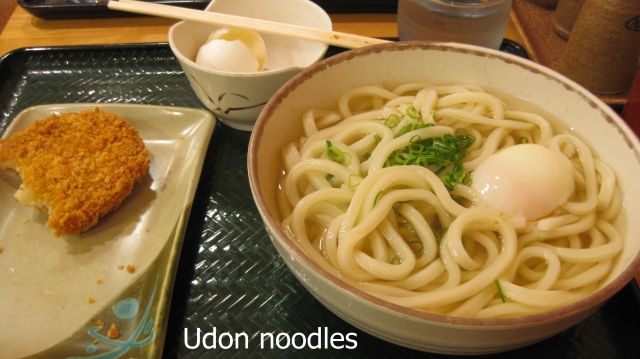Udon is a type of thick wheat-flour noodle of Japanese cuisine.
Udon is usually served hot as noodle soup in its simplest form as kake udon, in a mildly flavoured broth called kakejiru which is made of dashi, soy sauce (shōyu), and mirin. It is usually topped with thinly chopped scallions. Other common toppings include tempura, often prawn or kakiage (a type of mixed tempura fritter), or abura age, a type of deep-fried tofu pockets seasoned with sugar, mirin, and soy sauce. A thin slice of kamaboko, a halfmoon-shaped fish cake, is often added. Shichimi can be added to taste.
The flavor of broth and topping vary from region to region. Usually, dark brown broth, made from dark soy sauce (koikuchi shōyu) is used in eastern Japan, and light brown broth, made from light soy sauce (usukuchi shōyu) is used in western Japan. This is even noticeable in packaged instant noodles, which are often sold in two different versions for east and west.
Origin:
In China, similar thick wheat flour noodles are called cū miàn (粗麵). This original udon was 2 to 3 cm in diameter, a flat pancake-shaped “noodle” added to miso-based soup. The Japanese character 饂飩 is different from the modern Chinese characters 餛飩, which refers to wonton dumplings, not noodles. In Chinese, udon is called 烏冬 wūdōng or 烏冬麵 wūdōngmiàn, sometimes 烏龍麵 wūlóngmiàn, although it is unrelated to Oolong tea, 烏龍茶 wūlóngchá.
Like many Japanese noodles, udon noodles are served chilled in the summer and hot in the winter. Toppings are chosen to reflect the seasons. Most toppings are added without much cooking, although some are deep-fried. Many of these dishes may also be prepared with soba.




